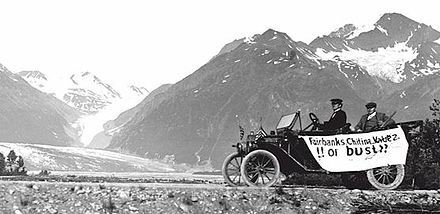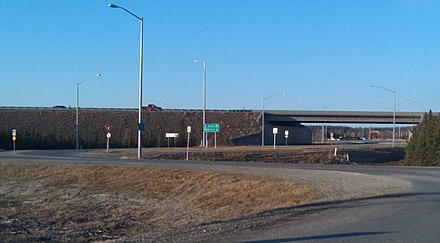The Richardson Highway is a highway in the U.S. state of Alaska, running 368 miles (562 km) and connecting Valdez to Fairbanks. It is marked as Alaska Route 4 from Valdez to Delta Junction and as Alaska Route 2 from there to Fairbanks. It also connects segments of Alaska Route 1 between the Glenn Highway and the Tok Cut-Off. The Richardson Highway was the first major road built in Alaska.[1]

Indigenous trade routes existed in the region going from Prince William Sound to the north of the Alaska Range into the Alaskan Interior starting at least 5000 years ago. The majority of the trade was facilitated by the Ahtna, but also included the Eyak and Sugpiaq to the south, and the Tanana Athabaskans to the north. The route of the Richardson Highway primarily follows part of this old trade network.[3][4]: 11, 51–53, 66
In 1885, Lieutenant Henry Allen's party crossed the eastern Alaska Range from the mouth of the Copper River to the Tanana River via Suslota Pass, the first non-natives to do so. In his report, he noted that it would be possible to build a road between Prince William Sound to the Yukon River.[5]: 4 Shortly after his expedition, gold discoveries in the late 1880s to mid 1890s north of the Alaska Range, such as in the Fortymile Mining District, at Birch Creek near Circle, and in the western Yukon, put pressure on the US Congress to explore Alaska. In March of 1898, the US Department of War funded three expeditions to explore Southcentral Alaska. Edwin Glenn led the expedition ordered to explore from Prince William Sound to Cook Inlet for routes between the Susitna and Copper rivers then northward to the Tanana River. Attached to the expedition was geologist Walter Mendenhall from the USGS.[5]: 6–10 They would eventually cross Isabel Pass, who were also the first recorded non-natives through that route, but fell short 15-20 miles from the Tanana River.[6] This pass received very little attention at the time.[3]
Concurrently, Captain William Abercrombie was ordered to explore from Valdez northward to the Copper River and tributaries of the Tanana River. By 1899, the Army ordered Captain Abercrombie to build a military road from Valdez to Copper Center then onto Eagle. Before winter of 1899, they had completed a 93 mile trail suitable for packhorses through Keystone Canyon and past Thompson Pass to the Tonsina River.[3][5]: 11 By 1901, the pack trail was completed, and provided an "all-American" route to the Klondike gold fields.[3] The total distance of the road was about 409 miles (660 km).[citation needed] After the rush ended, the Army kept the trail open in order to connect its posts for communication at Fort Liscum, in Valdez, and Fort Egbert, in Eagle. One way message times were generally around 6 months from the Yukon to Washington, D.C.[5]: 12 By 1904, the completion of the WAMCATS allowed near instantaneous communication from Fort Egbert to the US Capitol using an all American telegraph system.[7][5]: 14
The Fairbanks Gold Rush in July of 1902 drew attention away from the Klondike region, drawing prospectors to Fairbanks. These new travelers would follow the established Valdez-Eagle Trail until the Gakona River, and then utilize Ahtna trading trails through Isabel Pass to the Tanana Valley and finally unto Fairbanks. Most traffic using this route was during the winter with pack trains or sled dogs, since animals would tear up moss if it wasn't frozen, hampering travel.[8][9]: 27 Travel to the area during the summer was via riverboats.[5]: 21 The new traffic also enticed many to build roadhouses along the route, although many faced difficulty keeping them profitable.[2]
Along with the previous gold discoveries, the Fairbanks Gold Rush prompted the US Congress to send a senatorial party in 1903 to Alaska to hear testimony. At Eagle, Lieutenant William Mitchell told the party his estimated $2 million cost of building a road between Eagle to the Tanana River crossing, near Tok, then onto the Chena River confluence with the Tanana River. He suggested a route from Copper Center to the Tanana River crossing would be more cost effective. The senatorial party also met with Judge James Wickersham and Fairbanks resident Abraham Spring, both pushing for government led roadbuilding, opining that the miners could build feeder roads if a central road was built.[5]: 14–20
In early 1904, Congress passed legislation to build roads throughout Alaska. After surveys by the Army Corps of Engineers during the summer of that year, President Theodore Roosevelt appointed Major Wilds Richardson as the head of the Alaska Road Commission to supervise the construction of a wagon road from Valdez to Fairbanks starting in 1905.[2][5]: 23–30 [9]: 27 Richardson suggested dividing the trail into 3 sections, the first from Valdez to Copper Center along Abercrombie's route, the second from the mouth of the Delta River to Fairbanks, and the third connecting the two from Copper Center to Isabel Pass. Although Richardson contended with low funds and difficult construction, the road was finished in 1910.[2][5]: 34–47
During the construction, the government hired failed gold prospectors as well as regular construction workers. The income from this work allowed many of the prospectors to leave Alaska.
The rise of motorized travel led the road to be upgraded to automobile standards in the 1920s. To finance continued maintenance and road construction, the Alaska Road Commission instituted tolls for commercial vehicles in 1933 of up to $175 per trip, which were collected at the Tanana River ferry crossing at Big Delta. When the tolls were further increased in 1941 to boost business for the Alaska Railroad, disgruntled truckers nicknamed "gypsies" started a rogue ferry service in order to evade the toll.
The Alaska and Glenn highways, built during World War II, connected the rest of the continent and Anchorage to the Richardson Highway at Delta Junction and Glennallen respectively, allowing motor access to the new military bases built in the Territory just prior to the war: Fort Richardson in Anchorage, and Fort Wainwright adjacent to Fairbanks. The bridge at Big Delta, the last remaining gap, was built as part of the Alaska Highway project.
The southern end was only open during summers until 1950, when a freight company foreman who lived near the treacherous Thompson Pass plowed the snow himself for an entire season to prove the route could be used year-round. The highway was paved in 1957.
The Trans-Alaska Pipeline System, built in 1973-1977, mostly parallels the highway from Fairbanks to Valdez.

Richardson Highway is part of the unsigned part of the Interstate Highway System east of Fairbanks. The entire length of Interstate A-2 follows Route 2 from the George Parks Highway (Interstate A-4) junction in Fairbanks to Tok, east of which Route 2 carries Interstate A-1 off the Tok Cut-Off Highway to the international border.[10][11] Only a short piece of the Richardson Highway in Fairbanks is built to freeway standards.
![]() Media related to Richardson Highway at Wikimedia Commons
Media related to Richardson Highway at Wikimedia Commons